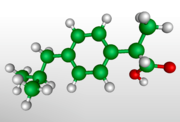|
Find information on thousands of medical conditions and prescription drugs.
|
|
|
Ibuprofen
Ibuprofen is a nonsteroidal anti-inflammatory drug (NSAID) widely marketed under various trademarks including Act-3, Advil, Brufen, Motrin, Nuprin, and Nurofen; a standing joke about some athletes' regular use has produced "Vitamin I" as a slang term for it. It is used for relief of symptoms of arthritis, primary dysmenorrhoea, and fever; and as an analgesic, especially where there is an inflammatory component. Ibuprofen was developed by the research arm of Boots Group. more...
 Home Home
 Diseases Diseases
 Medicines Medicines
 A A
 B B
 C C
 D D
 E E
 F F
 G G
 H H
 I I
 Ibuprofen Ibuprofen
 Idarubicin Idarubicin
 Idebenone Idebenone
 IFEX IFEX
 Iloprost Iloprost
 Imatinib mesylate Imatinib mesylate
 Imdur Imdur
 Imipenem Imipenem
 Imipramine Imipramine
 Imiquimod Imiquimod
 Imitrex Imitrex
 Imodium Imodium
 Indahexal Indahexal
 Indapamide Indapamide
 Inderal Inderal
 Indocin Indocin
 Indometacin Indometacin
 Infliximab Infliximab
 INH INH
 Inosine Inosine
 Intal Intal
 Interferon gamma Interferon gamma
 Intralipid Intralipid
 Invanz Invanz
 Invirase Invirase
 Iontocaine Iontocaine
 Iotrolan Iotrolan
 Ipratropium bromide Ipratropium bromide
 Iproniazid Iproniazid
 Irbesartan Irbesartan
 Iressa Iressa
 Irinotecan Irinotecan
 Isocarboxazid Isocarboxazid
 Isoflurane Isoflurane
 Isohexal Isohexal
 Isoleucine Isoleucine
 Isomonit Isomonit
 Isoniazid Isoniazid
 Isoprenaline Isoprenaline
 Isordil Isordil
 Isosorbide Isosorbide
 Isosorbide dinitrate Isosorbide dinitrate
 Isosorbide mononitrate Isosorbide mononitrate
 Isotretinoin Isotretinoin
 Itraconazole Itraconazole
 Ivermectin Ivermectin
 J J
 K K
 L L
 M M
 N N
 O O
 P P
 Q Q
 R R
 S S
 T T
 U U
 V V
 W W
 X X
 Y Y
 Z Z
Clinical use
Low doses of ibuprofen (200 mg, and sometimes 400 mg) are available over the counter (OTC) in most countries. Ibuprofen has a dose-dependent duration of action of approximately 4–8 hours, which is longer than suggested by its short half-life. The recommended dose varies with body mass and indication. Generally, the oral dose is 200–400 mg (5–10 mg/kg in children) every 4–6 hours, up to a usual maximum daily dose of 800–1200 mg. Under medical direction, a maximum daily dose of 3200 mg may sometimes be used.
Indications
Approved clinical indications for ibuprofen include:
- Rheumatoid arthritis (DMARDs should also be considered)
- Osteoarthritis, ibuprofen can reduce pain and, if present, joint inflammation
- Juvenile rheumatoid arthritis, alone or with corticosteroids
- Morbus Bechterew (spondylitis ankylosans) together with corticosteroids
- Rheumatic fever, together with antibiotic therapy
- Acute gout attack, ibuprofen is not useful for chronic treatment
- Primary dysmenorrhoea (ibuprofen proved superior to placebo and propoxyphen, and at least as effective as aspirin)
- Fever
- Pericarditis, chiefly after myocardial infarction, to reduce pain, fever and inflammation
- Minor aches and pains such as toothache, backache, fever and pain associated with common flu, symptomatic relief of influenza, shingles, and postoperative pain
- Sporting injuries and pain after mild to moderate trauma
- Headache including mild to moderate migraine attack
Off-Label and investigational use
- As with other NSAIDs, ibuprofen may be useful in the treatment of severe orthostatic hypotension (PMID 7041104)
- In some studies, ibuprofen showed superior results compared to placebo in the prophylaxis of Alzheimer's disease, when given in low doses over a long time (PMID 16195368). Further studies are needed to confirm the results, before ibuprofen can be recommended for this indication.
- Ibuprofen has been associated with a lower risk of Parkinson's disease, and may delay or prevent Parkinson's disease. Aspirin, other NSAIDs, and acetaminophen had no effect on the risk for Parkinson's (PMID 16240369). Further research is warranted before recommending ibuprofen for this use.
Ibuprofen lysine
In Europe and Australia, ibuprofen lysine (ibuprofenlysinat, the lysine salt of ibuprofen) is licensed for treatment of the same conditions as ibuprofen. Ibuprofen lysine is said to have a more rapid onset of action compared to base ibuprofen.
Mechanism of action
Ibuprofen is an NSAID which is believed to work through inhibition of cyclooxygenase (COX); thus inhibiting prostaglandin synthesis. As with other NSAIDs, ibuprofen inhibits platelet aggregation, but is not used therapeutically for this action since it is a minor and reversible effect.
Read more at Wikipedia.org
• [List your site here Free!]
|
|
|
|
Preliminary comparison of bromelain and ibuprofen for delayed onset muscle soreness management - Brief Article
From Alternative Medicine Review,
2/1/03
by MB Stone
Stone MB, Merrick MA, Ingersoll CD, Edwards JE. Clin J Sport Med 2002;12:373-378.
OBJECTIVE The purpose of this study was to determine whether a common bromelain regimen or common ibuprofen regimen are effective in resolving pain and muscle dysfunction associated with delayed onset muscle soreness of the elbow flexors. DESIGN A randomized, double-blinded, repeated measures design was used for this study. SETTING The study was performed in the Sports Injury Research Lab at an NCAA Division I university. PARTICIPANTS Forty subjects who had not participated in an upper body resistance-training program 3 months prior to the study, suffered pain or injury in the nondominant arm. or experienced an adverse response to nonsteroidal anti-inflammatory drugs or pineapple (bromelain source) were recruited. Thirty-nine subjects finished the study. INTERVENTIONS Active range of motion (ROM), perceived pain, and peak concentric torque measurements of the nondominant arm were taken prior to and 24, 48, 72, and 96 hours following an eccentric exercise protocol of the elbow flexors. Subjects were assigned to one of four treatment groups (bromelain 300 mg t.i.d., ibuprofen 400 mg t.i.d., placebo t.i.d., and control) and began treatment immediately following the exercise protocol. MAIN OUTCOME MEASURES No differences among treatments were observed for any of the dependent variables at any time. ROM deficits and pain peaked between 48 and 72 hours. Peak torque deficiencies were observed between 24 and 72 hours. CONCLUSIONS Ingestion of bromelain and ibuprofen had no effect on elbow flexor pain, loss of ROM, or loss of concentric peak torque as a result of an eccentric exercise regimen.
COPYRIGHT 2003 Thorne Research Inc.
COPYRIGHT 2003 Gale Group
Return to Ibuprofen
|
|



